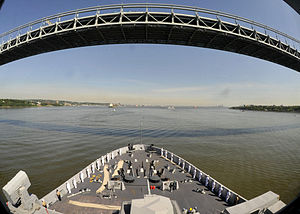The Narrows (New York City)
| The Narrows | ||
|---|---|---|
| The Narrows (highlighted in red) on a satellite image of New York | ||
| Connects waters | Upper New York Bay | |
| with water | Lower New York Bay | |
| Separates land mass | Staten Island | |
| of land mass | Brooklyn | |
| Data | ||
| Geographical location | 40 ° 37 ′ 24 ″ N , 74 ° 3 ′ 19 ″ W | |
|
|
||
| length | 5.5 km | |
| Smallest width | 1.5 km | |
| bridges | Verrazzano Narrows Bridge | |
| USS New York (LPD 21) entering New York Harbor in the Narrows Strait | ||
The Narrows is a strait in New York City . It separates the boroughs of Staten Island and Brooklyn and connects Upper New York Bay with Lower New York Bay .
location
The approximately 4.5 kilometers long waterway is a tidal body and the main gateway to New York Harbor . It offers the bays behind it protection from the Atlantic . The Narrows is about 1.7 kilometers wide at its narrowest point in the south, and about 3.2 kilometers wide on the northern side. The entrance to the strait from the south is marked by the lighthouse Coney Island Light , which is located at the western end of the island of Coney Island at Nortons Point.
history
The Narrows was only formed about 12,000 to 13,000 years ago, before that Staten Island and Brooklyn were connected by the deposition of a moraine from the last Ice Age (about 18,000 years ago). At that time, the Hudson River drained through the bed of what is now the Raritan River . The breakthrough opened The Narrows, and erosion widened the canal to its current shape.
The first documented entry into the strait was made by the Italian navigator Giovanni da Verrazzano . He anchored there and was greeted by Delaware Indians who paddled out onto the Narrows in boats.
Crossing
The Verrazzano-Narrows Bridge , which connects Staten Island and Brooklyn and crosses the strait, is named after Giovanni da Verrazano . After its completion in 1964, it was considered the largest suspension bridge in the world until 1981.


